Over the years, I've run into several styles of concrete septic tanks. The images I've created below should help you locate and identify what tank you have and where the cleanout hatches are. This is only a guide and there are other styles out there. These are just the most common types I see. There are also a few different configurations of metal and poly tanks as well. That page will be coming up in the near future.
Important: Probably the most important component of a septic tank is the "outlet baffle". Please be sure to inspect this once in a while and repair/replace it as necessary. If this fails, your leach field will be ruined in a very short time. Please unearth the "inlet" and "center" covers as well because they are necessary for a thorough pump out.
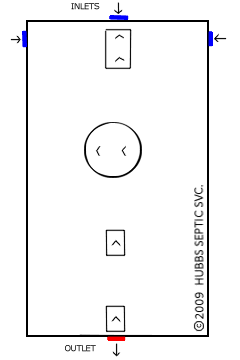
PS 2comp1000
(10' length) This tank was manufactured by P&S
concrete in North Chittenango, NY. The original style hasn't changed other
than an upgrade from thin wire handles to heavy wire. Commonly used from 1980-present. Newer versions from this Mfg have three 18" round poly lids.
|

Deal's 2comp1000
(10'6" length) This tank was originally manufactured by Deal's
Precast in Vernon Center, NY. We've been installing
this style tank from 1995-present. Although today, it's made by American Concrete in Canastota, NY
|
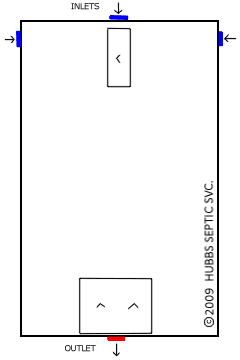
Sunnycrest1000 A
(8' length) This tank was manufactured by Sunnycrest
Precast in Auburn, NY. This tank has been referred
to as the "Dean Hubbs tank" due to the nearly
exclusive local use by our company for many years. We
installed literally hundreds of these tanks from 1978-1993
|
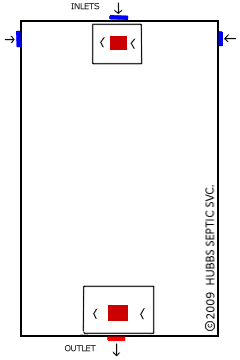
Sunnycrest1000 B
(8' length) This tank was manufactured by Sunnycrest
Precast in Auburn, NY. We installed these tanks from 1993-1995. There is also a 2-compartment version that has a lid in the center as well. The outlet baffle was made of PVC and attached with stainless steel pins.
|
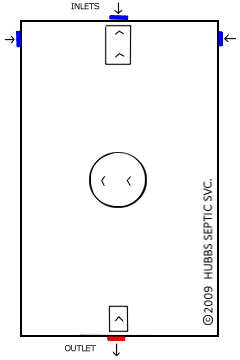
PS 1comp1000
(8' length) This tank was manufactured by P&S
concrete in North Chittenango, NY. Style wasn't
changed for many years other than an upgrade from thin wire handles
to heavy wire. Rarely used from 1980 (to around) 2000. For the last few years they've been using round green plastic riser covers.
|

Attached baffle 1000
(8' length) This tank is responsible in part for my
ailing back. The manufacturer cast the baffles onto
the lids! When the unsuspecting worker attempts to
lift the cover, he gets about 12 inches of lift and
only then does he realize the assumed 30 lb cover is
actually 100 lbs! It is common for these baffles to
break off (easily repaired).
|
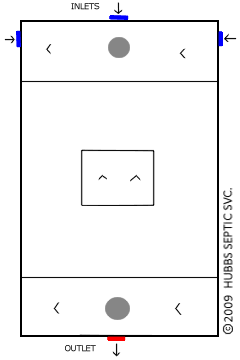
Old Style A
(8' length) If your home was built in the 1960's and
the contractor installed a concrete tank instead of
metal, you probably have this tank in your lawn. The
end covers come off and are VERY heavy and fragile.
This one also has a 24" center cover.
|
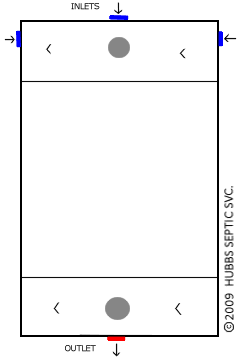
Old Style B
(8' length) Another version of the 1960's tank is
nearly identical to "style A" without the handy
center cover. Styles "A and B" were both notorious
for outlet baffle "rot-off" (easily repaired).
|
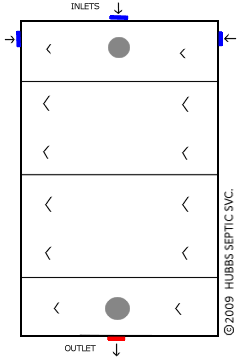
|
Old Style C
(8' length) Yet another version of the 1960's tank
is nearly identical to "styles A and B" only in
addition to the end covers, there are two more
larger removable sections.
It should be noted that all three styles "A, B, and
C" were optionally available with knock-out plugs on
the inlet and/or outlet covers. Many homeowners have
these broken out for use as a cleanout and some even
have a pipe installed as a riser to bypass the
trouble of removing the large cover. Just so you
know, the smaller the opening for a cleanout, the
less sludge a pumper will be able to remove. It is
advisable to remove at least one large cover on any
tank to get a thorough pump job.
|